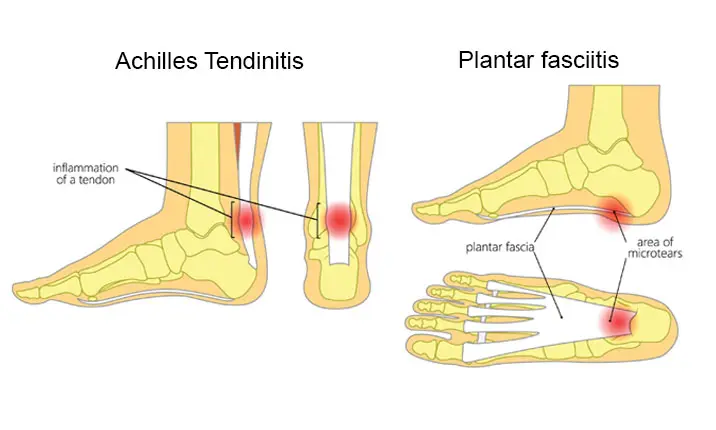Dancing is a way of life in many cultures all around the world. Underlying the beauty of dancing is a series of complex and dynamic footwork, performed repetitively to achieve pinpoint finesse in its execution. The countless hours of practice though, places extremely high stress and strain on the dancer's foot and ankle. With each practice easily lasting several hours a day, dancers often risk stress fractures and other overuse injuries. Here, we look at some of the most common foot and ankle injuries dancers typically suffer from:
1. Bunion
A bunion is a growth on the side of the big toe and can be painful. Bunions are one of the most common issues for dancers and is the result of an abnormality where instead of being straight, your big toe leans in towards your second toe. It is frequently exacerbated due to the wearing of shoes that are too small or tight, as well as from the pressure on the front of the feet during dancing. Left untreated, it can result in a permanent painful deformity that may even affect the second and third toes.
Bunion symptoms
Symptoms of a bunion include:
- A red, swollen, bulging bump on the outside of the base of your big toe
- Soreness around your big toe joint called hammertoes
- Corns or calluses (thickened skin) that often develop where the first and second toes rub against each other
- Pain that may be continuous or occur intermittently
- Inability to bend your big toe, or experiencing pain and burning when you try to bend it
- Not able to wear regular shoes
Bunion treatment
Non-surgical treatment for bunions involve wearing wider and softer or padded footwear. Foot supports or orthotics like splints and in-soles can help to reduce the deformity and pain.
Bunions may progressively worsen where the pain and swelling cannot be relieved completely with non-surgical treatment. In such cases, surgery can be performed to correct the deformity and relieve the symptoms. Surgery will involve removing some of the bone to correct the big toe's position, and to remove swollen tissue from the affected joint.
2. Sprained Ankle
A sprained ankle is one of the most frequent lower limb injuries, and is very common when dancing. Ankle sprains can occur when a dancer lands from a jump or rolls their ankles incorrectly, over-stretching or even tearing the ankle ligaments.
Depending on the severity of the sprain, the ligament injury can vary from a partial to a complete tear of the ligament.
Symptoms of a sprained ankle
Most people are very familiar with the symptoms of an acute ankle sprain, which manifests as pain and swelling commonly over the outer ankle region. Other signs and symptoms of a sprained ankle can vary according to how severe the sprain is and may include:
- Pain in the joint that may throb, especially when you bear weight on the affected foot or move your foot
- Tenderness when you touch the ankle
- Swelling and bruising
- Redness and warmth due to more blood flow in the area
- Difficulty walking
- Instability in the ankle and a feeling of weakness
- Popping sensation or sound when the injury happened
Treating a sprained ankle
Most ankle sprain injuries respond well to RICE therapy (which stands for rest, ice, compression and elevation), and patients can typically return to dancing in a few weeks. Using ankle braces or crutches to avoid putting weight on the ankle is recommended.
In cases where the pain in the ankle is severe, it may be necessary to perform an X-ray to exclude the possibility of more severe injuries such as a fracture or complete ligament tear.
Significant tears of the ankle ligaments may be treated with physiotherapy involving strengthening and balance training. In cases where significant instability of the ankle is present, surgery for reconstruction of the torn ankle ligaments may be necessary to restore stability to the ankle joint.
3. Stress Fractures
A stress fracture is defined as a hairline crack within the bone and occurs due to overuse or repetitive impact where damage is done to the bone over time. It often happens to people who suddenly increase the frequency, duration or intensity of their exercises without proper incremental training or sufficient rest in between exercises.
In dancing injuries, it frequently occurs in the metatarsal bones of the foot, usually the second and third metatarsal bone. Patients will experience pain when walking, and there is often swelling at the top or bottom of the foot.
Diagnosis of a stress fracture can be made via a physical examination, bone scan, magnetic resonance imaging (MRI) or X-ray of the foot.
Stress fracture symptoms
Symptoms of a stress fracture include:
- Pain that develops gradually and worsens during weight-bearing activities
- Pain that begins after starting an activity and then diminishes during rest
- Pain that's present throughout an activity and does not go away after the activity has ended
- Pain which occurs while resting, during normal daily activity or with everyday walking
- Pain which is worse with hopping on one leg or being unable to shift weight or hop on affected leg or foot
- Tenderness when touched at the fracture site
- Swelling or aching on the top of the foot or on the outside of the ankle
Stress fracture treatment
The treatment for stress fractures usually includes RICE therapy (mentioned above), and anti-inflammatory drugs to help with managing pain and swelling. The use of a walker boot is useful in patients who have significant pain when walking. Some stress fractures may require surgery where pins or screws are used to hold the bones together during the healing process. Stress fractures usually heal in 1 – 2 months.
4. Achilles tendinitis and Plantar fasciitis
The Achilles tendon connects the heel bone to the calf muscle. Achilles tendinitis is the inflammation to the Achilles tendon caused by intense, repeated physical activity. Plantar fasciitis is inflammation of the tissue that runs across the bottom of the foot and connects the toes to the heel bone.
Achilles tendinitis and plantar fasciitis symptoms
Symptoms of Achilles tendinitis include:
- Pain along the back of the leg or above the heel after sports activities
- Episodes of more severe pain after running, climbing stairs or sprinting
- Pain that becomes more severe the day after exercising
- Pain and stiffness along the Achilles tendon especially in the morning, which improves with mild activity
- Swelling that worsens with activity
Symptoms of plantar fasciitis include:
- Pain at the bottom of the heel or bottom of the mid-foot area
- Burning sensation or aching that extends outward from the heel
- Pain that may be dull or sharp
- Pain that worsens when walking after not moving for a while
- Heel stiffness causing difficulty in climbing stairs
- Flare-ups due to increased irritation and inflammation
Treating Achilles tendinitis and plantar fasciitis
Treatment involves stretching exercises to the ankle and foot, as well as ultrasound or shockwave therapy to the injured tendon or fascia. Platelet-rich plasma therapy, which is the injection of a concentrate of the patient's own blood plasma rich in healing factors, has shown good results in many studies in the treatment of recurrent Achilles tendinitis or plantar fasciitis.
Achilles tendinitis and plantar fasciitis can often become a recurrent problem, especially in patients who have longstanding tightness in their calf muscles. Surgical treatment may be required in patients who have persistent pain despite conservative treatment, and this may involve lengthening of the calf muscle or the plantar fascia of the foot.
How do I know if the pain is from an injury?
Most of the time, any pain you experience after dancing is due to sore muscles that usually goes away within 24 – 48 hours. However, you may have suffered an injury if you experience pain that:
- Wakes you up when you're sleeping
- Is present when you start an activity
- Increases while doing an activity
- Causes you to compensate with your movements like shifting your weight
If you do experience such pain, consult a medical specialist, preferably an orthopaedic specialist or a physical therapist with experience in treating dance injuries.














